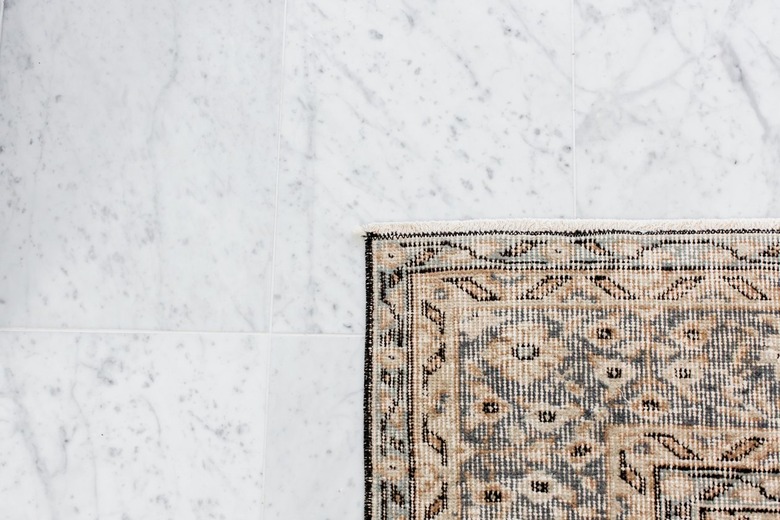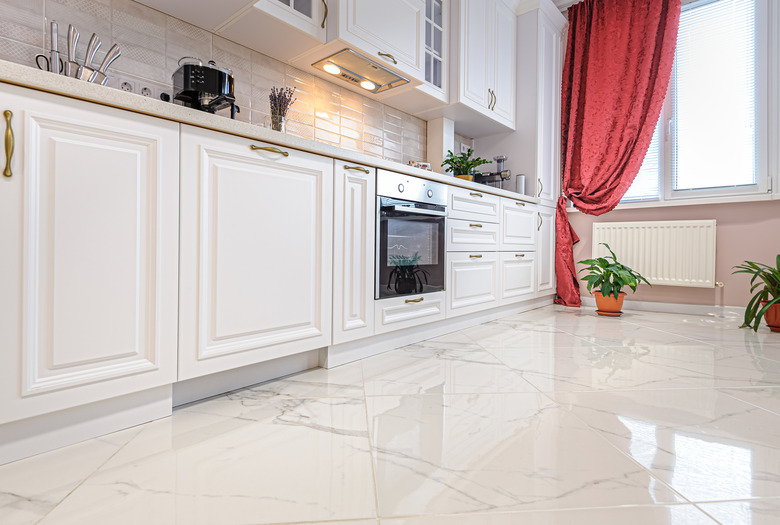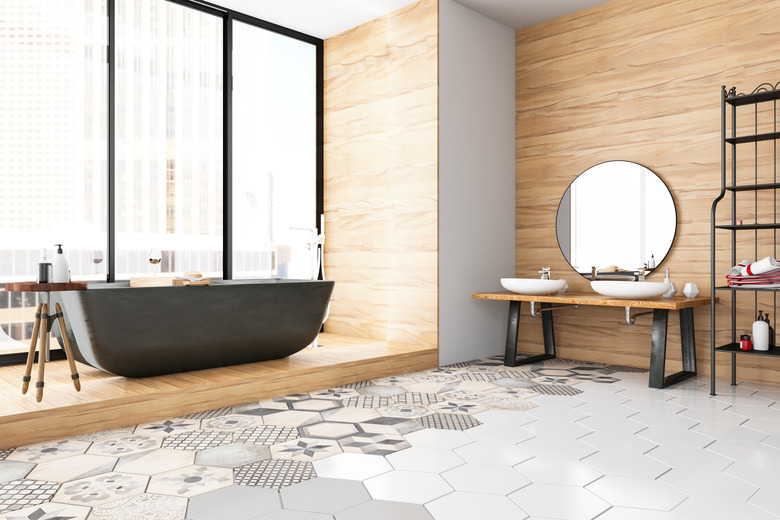Marble Tile: A Homeowner's Tile Flooring Guide
If you're thinking of redoing the floors in your home, then there are many different types of tiles from which to choose, with marble tile being one popular option. In the kitchen and bathroom, these tiles are often a good choice, primarily due to their ability to hold up well to moisture and foot traffic while also being easy to clean and maintain.
However, choosing the right tile flooring for your home can feel a bit overwhelming with so many kinds available. There's porcelain, ceramic, granite and travertine, just to name a few. Due to its unique qualities, marble tile is often considered in a league of its own. However, it's worth understanding the nitty gritty of this tile before installing it in your home.
About Marble Flooring
About Marble Flooring
According to BuildDirect, marble is a natural stone that has been used in building materials and architecture for centuries. It was luxurious in ancient Greece — and still is today. Marble has never really gone out of style, but tastes in certain types of marble styles have changed over the years as more options have become available.
Marble is a metamorphic rock, or a natural stone tile, that is sourced from quarries all over the world, including Spain, India, Turkey, Great Britain, Greece, Italy, Belgium and France. According to M S International, quarrying tile has become easier due to technological advancements.
Marble is extremely durable and can hold up for quite a long time. As it has stood the test of time in major sites around the world, there's no doubt that marble wouldn't be held to the same standard in your home. Marble is known to make a statement. Using marble in your kitchen, bathroom, hallways, entryways or other rooms of your home will give it a look that other tiles and flooring simply cannot.
Different Types of Marble Flooring
Different Types of Marble Flooring
One of the biggest distinctions between different types of marble tile is the color variation. Because marble is a natural stone, these variations are truly unique. For instance, you can even find black marble, though it's not as common.
According to Avalon Flooring, in addition to these color variations, you can also find different vein patterns, hues and grains. Some marble types from which to choose are:
- Carrara: Carrara is one of the most common marble types found in homes, particularly in bathrooms because of its stark whiteness. It comes in shades from white to gray to blue-gray, with fine veins running through each tile. Carrara marble may sometimes be referred to as Carrara white, white Carrara or Bianco Carrara depending on the type.
- Statuary: Statuary tiles are very similar to Carrara, but the veining is more pronounced. The tones can be different hues of gray, and it has a very glossy look to it.
- Calacatta: Calacatta is a rare stone that often gets confused with Carrara. One way to tell them apart is because the veins in Calacatta are thicker, and the background is usually white marble. It looks great in kitchens with stainless-steel appliances.
- Emperador: If you want a tile with a different coloring altogether, then the brown Emperador tiles may be right for you. In this tile, you can find fine grains, and the darker look would be ideal if you want to give a room a cozier feel.
- Crema Marfil: Crema Marfil has a yellowish or beige color that's rather uniform, with some irregular veins running through it.
Styles and Patterns of Marble Tiles
Styles and Patterns of Marble Tiles
Once you decide the type of marble tiling you prefer, you can choose from different styles and patterns. Because marble is a flexible material, it can be cut into designs and shapes that you have in mind, and unlike other types of tile, marble can be catered to your very specific tastes. However, if you don't have any particular preference, the more common tile styles and patterns available include:
- Herringbone: Herringbone uses rectangular-shaped tiles to make an alternating cross-cross effect of tiles with different colors, which looks similar to bricks but at all different angles.
- Brick: Just as it sounds, it is great for a kitchen floor.
- Repeating: Any repeating combination of different-colored marble tile to create an interesting look, like a checkered floor
- 3D: Multiple shades of color to create an optical illusion or 3D effect
- Bordered: Use a border and different styles of tile to have an interior look bordered by an exterior look. This is ideal for hallways and entryways but also works in kitchens, living rooms and bathrooms.
- Mosaics: You're not limited to mosaic tile designs and medallions solely with ceramic tiles. You can also do beautiful geometric designs like hexagons with marble tiling that will give off the wow factor.
Pros and Cons of Marble Tile
Pros and Cons of Marble Tile
There's a chance that not everything about marble tiling will be perfect for you. Before investing in marble tile, it's important to weigh the pros and cons and determine if this is what you want to use for the flooring in your home. According to Inova Stone, there are several pros and cons to consider with marble tiles:
Pros:
- A look of luxury that's hard to come by with other types of flooring
- Hypoallergenic
- Durable
- Available in so many different types and styles that you'll have no problem finding marble tiles that meet the look you desire
- Lasts a very long time, so it will likely never need to be replaced during your lifetime.
- Reflects light with its glossy appearance, inviting in natural light and making a room appear larger and more open.
- Easy to install over in-floor heating heating and naturally cools homes.
- Increases the overall value of your home.
- Relatively easy to install.
Cons:
- One of the most expensive flooring options (especially in natural stone).
- Can crack under certain weight and will need to be well maintained by resealing it.
- Very absorbent, which means it doesn't stand up well against stains or anything acidic — which is why it's not ideal for countertops and requires careful attention paid to your cleaning products.
- Can rust over time.
Installation of Marble Tile
Installation of Marble Tile
One of the pros of marble tile is that it's rather easy to install. However, it will still take a lot of planning and care, and if you do not feel comfortable doing it on your own, then it may be helpful to call in a professional. Each marble tile installation will have specific requirements for installation, so be sure to read those directions carefully. BuildDirect provides general installation directions.
After you've measured your room and ordered your tiles, you'll need to gather a few other materials and tools, such as an anti-fracture membrane, a notched trowel, tile spacers, a T-square, line chalk, mortar, a rubber mallet, marble sealer and grout just to name a few. Sometimes, home improvement stores sell tile installation kits so you can get everything you need in one place.
Once you have all your materials and tools, the first step is to prepare the substrate, which is the base of your tile that's installed directly over your plywood subfloor, which must be flat. The substrate is created when you take your notched trowel and thinset mortar, which you'll spread across the plywood and then attach your anti-fracture membrane to it with screws.
After you're certain everything is smooth and flat, it's time to figure out where you'll place the tiles by using a T-square and line chalk. Always start in the center of the room to determine where the exact center is located and then mark it. Prepare your mortar little by little and spread it on the back of each tile, placing them down carefully along the marks you've made. You may have to cut some tiles using a wet saw if your tiles don't go exactly to your walls
Lastly, after all your tiles are placed, you will need to seal it to protect the tiling from damage. Use a marble surface sealer agent to do this. Then, use a grout float to apply grout to the joints between your tiles. When you're finished, apply another layer of sealant.
Cleaning and Maintenance Tips
Cleaning and Maintenance Tips
After installing your marble tile, it's important to keep the marble in the best shape possible by cleaning it and maintaining it consistently. Despite the fact that marble tile has a long lifespan, it needs help to retain its luster and quality.
There are a few things to keep in mind when cleaning and maintaining marble, whether it's cleaning it up immediately after an accident or consistently keeping it clean day after day. First, marble flooring requires a good resealing every year or so. Though this does not prevent marble from getting stained, it does help it resist stains a little better. Of course, trying to avoid spills and messes altogether is your best bet for keeping your marble flooring as fresh as possible.
Next is general cleaning. Because marble tile can get etched easily from acidic substances, stick to warm, soapy water to get the job done. Before you mop, though, sweep any dust and dirt off the floor tile to avoid abrasions. After you mop, make sure the floor tile gets dried well. You can do this daily.
Last is knowing what to do if someone accidentally spills something on your marble floor or drags dirt onto it. Try mixing 12 percent hydrogen peroxide with ammonia to use on difficult stains. Otherwise, use a cleanser that's acid-free, like a household detergent. If over time you start to notice etching on your marble flooring, then consider using #0000 steel wool to buff it. If you're really having difficulty getting stains out, don't risk making them worse — call in a professional.
Cost Factors to Consider
Cost Factors to Consider
Marble flooring is one of the most expensive types of flooring, and it's worth getting an idea of what those costs can be so that you can decide whether or not marble is the right choice for you. According to HomeAdvisor, marble tiles can range from $5 to $40 per square foot. This cost is influenced by the grade of the marble, size, thickness and finish.
Next is installation. If you call in a professional to install your marble flooring, then you'll be looking to spend between $3.26 and $7.02 per square foot. This is not taking into consideration the cost of materials or other factors, like floor removal, moving furniture and repairing any damages in the subfloor. While you can save money installing tile on your own, always do the calculations to compare the cost of doing it yourself to hiring help.
You will also have to take into consideration your finish options and whether or not you want honed tile or extra-polished marble tile, for example. According to Floor Master, honed is when the stone is ground to a smooth, flat surface that takes the shininess away and gives it more of a matte finish that appears softer and delicate compared to polished marble.
Marble tiles come from many different places around the world, and there are hundreds — if not more — of distributors that offer a wide array of choices. Feeling overwhelmed by what's out there? Visit your local home improvement store and see what different brands have to offer. You can also look at various brands online.



